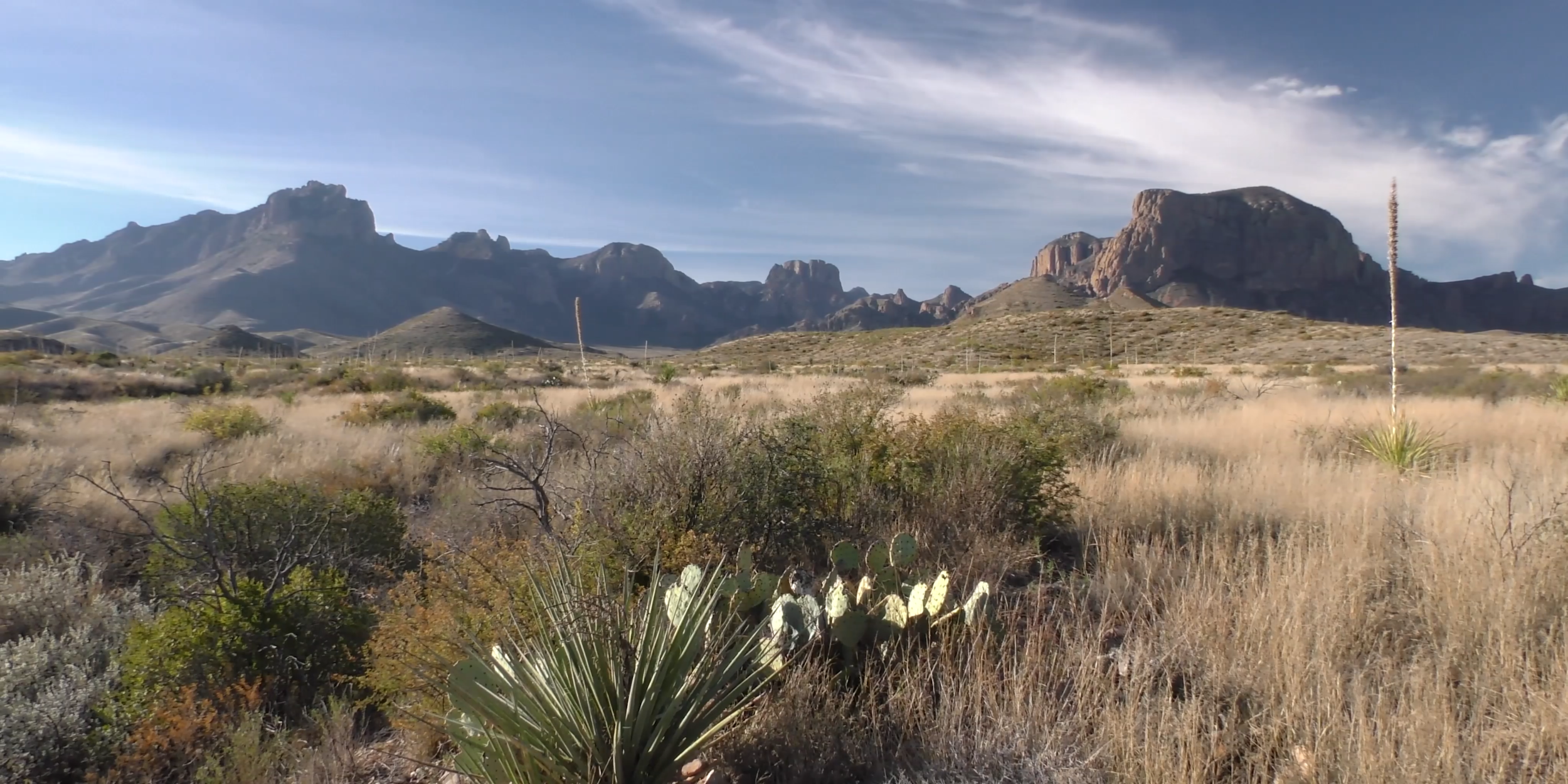
Development by Design in West Texas:
Mitigating Energy Sprawl Through Cooperative Landscape Planning
Kei Sochi, Jon Paul Pierre, Louis Harveson, Patricia Moody Harveson, David V. Iannelli,
John Karges, Billy Tarrant, Melinda Taylor, Michael H. Young and Joseph Kiesecker
May 2021
1. Introduction
WHO WE ARE
The Respect Big Bend Coalition includes Big Bend organizations and landowners, organizations and companies with projects and operations in West Texas and scientific experts. We share a commitment to the future of far West Texas. Our mission is to inspire and empower all stakeholders to conserve the unique resources and protect the iconic communities of the Big Bend Region of Texas while developing energy responsibly.
We are dedicated to collaborating with communities and landowners to maximize the benefits of responsible energy development while sustaining the communities, land, water and wildlife of the Big Bend region.
The coalition was established by the Cynthia and George Mitchell Foundation, a Texas foundation that supports projects at the nexus of environmental protection, social equity and economic vibrancy. To learn more about the Respect Big Bend Coalition visit RespectBigBend.org
This project is about harnessing a regional stakeholder planning process to advance low-impact energy development that mitigates potential impacts to locally significant ecological and social-cultural assets. We forecast the growing energy demand and identify the places where that demand is likely to be met – in the form of traditional and renewable energy: oil and gas, solar and wind. This information is mapped against areas representing the ecological and social-cultural values that define the character of the Big Bend Region. When considered together, we can improve the likelihood of finding a new energy roadmap that accommodates development while ensuring the persistence of those regional values considered most evocative of the landscape that generations have called home.
Why is this necessary?
By 2050, there will be between two and three billion more people on our planet than there are today. They will all need food, housing and access to energy [1, 2]. These growing demands pose significant challenges for the natural resources needed to accommodate the expected growth in energy production. In a world seeking to decarbonize energy production, this demand would be met by increasing renewable energy sources such as solar, wind and hydropower [3–6]. Avoiding climate projections most accepted by many scientific experts will require achieving net-zero greenhouse gas emissions by mid-century, which in turn necessarily involves a transition to renewable energy.
But renewables, even with their environmental appeal, are not without their own impacts to wildlife and biodiversity [7]. Solar panels are land-intensive [8]; turbine blades from windmills strike birds and bats; hydropower development interferes with fish migration and distorts natural flood regimes; and transmission lines linking utility-scale renewable energy into our power grid fragment habitats and become conduits for the spread of non-native species [9]. Renewable installations sited without careful consideration can adversely impact significant social and cultural values, wildlife habitats and critical ecosystem services in a place.
Texas is not immune to these same development pressures. In many ways Texas is a microcosm for how these trends will play out on the global stage. Today, Texas’ population is approaching 29 million people [10]. That number is predicted to surge to nearly 55 million by 2050, with most people clustered in already-dense urban centers. The attendant increase in demand for energy, food and water resources will need to be met by ecosystems that are already under stress from extended droughts, record-breaking heat waves and devastating floods [11].
Nowhere is this concern more acute than in West Texas, one of the most energy-intensive places in one of the most biologically diverse desert systems in the United States [12]. The nation’s top producer of crude oil and natural gas and the leading generator of wind-powered energy in 2019, Texas is also the largest energy-consuming state in the United States [13]. Finding solutions that balance energy development with the resident biodiversity and within expanses of unbroken open space valued by the rural and ranching communities and recreationalists alike is a challenge.
In Texas, this challenge is compounded by the fact that 95 percent of the land is privately-owned. That means that most of the energy development in the state – oil and gas, as well as renewables – also occurs on private land. Currently, decisions about where to site new facilities are made by energy companies and private landowners, with little input from other stakeholders. This process makes it extremely difficult to plan energy development that avoids negative landscape-level impacts while meeting growing energy demands.
Moreover, in Texas, there are few regulatory requirements related to siting new energy facilities on private lands. As described in Section 5, oil and gas operators must obtain a drilling permit from the Railroad Commission of Texas before drilling a new well, but the permit review does not include consideration of the spatial impacts of development. No state permit is required prior to construction of a new wind farm or solar facility. As is the case for oil and gas, provisions designed to reduce the land impact of renewable energy development are included in agreements between the private landowner and the operator, either in the lease agreement or, in some cases, a surface use agreement. But those instruments are not especially relevant to impacts at the broad, landscape scale.
So, what then are the options?
One option is to reduce demand – to decouple human well-being from cheap energy. This would be done through increased efficiency and improved technologies for energy storage and transmission, which would lower pressures for massive new energy development [14]. But even the most optimistic projections of social change and energy innovation cannot slow the short-term need for still ambitious energy developments that are already part of national and regional development plans [5].
A second approach would be to object to new, specific energy projects that potentially conflict with the characteristics of those places people value. But a strategy focused on curtailing energy impacts one project at a time is costly; risks social and political resentment; and does little to resolve the energy supply gap [15].
A third course of action would be to co-design the development and delivery of energy in such a way to maintain biodiversity and other values, such as recreational opportunities or viewsheds. This is the approach proposed here. Data and modeling can be used to identify “areas of lower conservation value” for energy development and “areas of high conservation values” as zones for continued conservation, restoration, protection and preservation [16–18]. The hypothesis underlying this approach is that, by identifying low-impact places where energy development might go, one also gains leverage to secure high conservation value and “no-go” areas.
This path tackles three big and connected problems together:
low-cost energy access for everyone;
habitat and wildlife protection in the context of new pressures for land conversion from expanding energy development; and
climate change projections that drive the urgent push for a more rapid transition to a decarbonized economy.
Moreover, managing each of these three problems alone, much less all together, will require engaging a diverse group of stakeholders, scientists and land use decision-makers at the same table, at the same time, in a collaborative manner.
Proactive landscape-level planning that accounts for land use constraints, supports private landowner rights and effectively manages the health of conservation values in the siting of energy infrastructure is needed to meet growing demands for energy in a low-impact, low-conflict manner. Instead, oftentimes traditional energy development planning is ad-hoc, project-by-project, and can fail to consider cumulative impacts at meaningful scales. It narrowly focuses on site-level impacts of a particular project rather than how it contributes to the cumulative negative impacts of multiple development projects taken together within a broader landscape [19]. As a result, money spent on mitigation efforts to avoid, minimize, restore or offset potential impacts often flounders in efforts to make lasting positive gains for conservation [20]. With the work presented here, we seek to move away from piecemeal, reactive development planning and to move toward planning at early stages that proactively identifies likely impacts, minimizes avoidable conflicts and improves mitigation, restoration and conservation action.
Developers or conservation practitioners seek to reduce development impacts through application of the mitigation hierarchy: avoid, minimize, restore and offset. To avoid impacts on conservation values, measures are taken to prevent impacts from the outset, such as through careful spatial or temporal placement of development footprints or impacts. To minimize, measures are taken to reduce the duration, intensity and/or extent of impacts that cannot be completely avoided. With restoration, measures are taken to rehabilitate degraded ecosystems after impacts that cannot be completely avoided and/or minimized have occurred. Finally, to offset impacts measures are taken to compensate for any residual adverse impacts that cannot be avoided, minimized and/or restored. These actions typically occur away from where the development footprint/impacts have occurred. Offsets can take the form of positive management interventions such as restoration of degraded habitat or protecting areas where loss of conservation values is imminent. Attempts to meet conservation goals through the application of the mitigation hierarchy have gained wide traction with increased development of public policy, lending standards and corporate policy.
To advance this process in West Texas, the Respect Big Bend team together with the Stakeholder Advisory Group drew on decades of conservation planning experience with a history of achieving on-the-ground conservation results that also benefit people. Following The Nature Conservancy’s Development by Design framework, our team embarked on this effort to help decision-makers avoid and mitigate potential conflicts between development objectives and conservation priorities.
The following steps help to achieve better outcomes for people and nature:
Develop a landscape conservation vision that asks: what are the values people want to maintain and thus where are the highest priority areas for conservation action in the landscape?
Project future potential energy development. Where is future oil and gas, solar, and wind development likely to expand into?
Clarify the impacts and tradeoffs. How might conservation values (i.e., biodiversity, social and cultural values) be impacted by potential future energy development?
What mitigation actions can be deployed to efficiently and effectively mitigate potential impacts?
What policy, legal and educational tools and resources are available to mitigate potential impacts? What can be learned from government agencies that lease public land for energy development?

